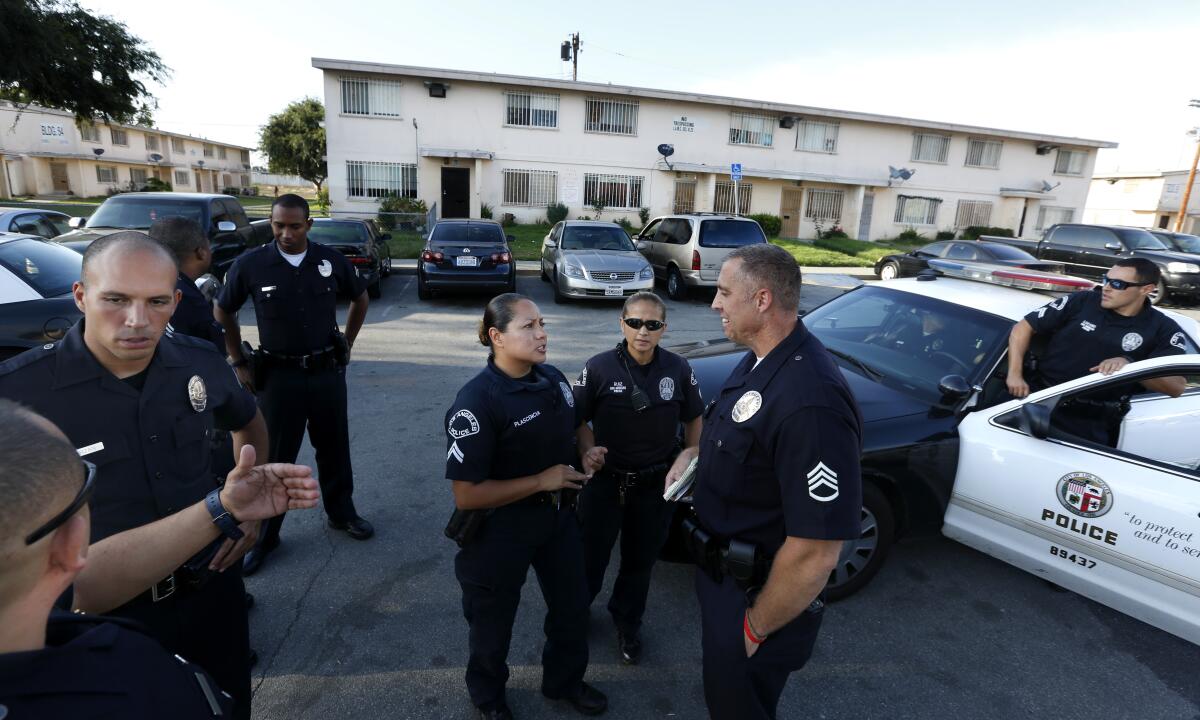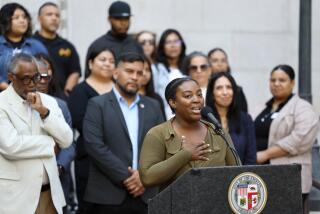LAPD community policing has prevented crime and made residents feel safer, study finds

The Los Angeles Police Departmentâs signature community policing program has prevented crime and made residents feel safer in public housing developments with entrenched gang problems and troubled relationships with law enforcement, according to a study by UCLA researchers.
But challenges remain for the Community Safety Partnership, including confusion about its mission and perception that it fails to help teenagers at high risk of gang involvement, the researchers wrote in the report, which they presented to the five-member civilian Police Commission on Tuesday.
âPeople felt it was safer to go outside, mingle with people, use green spaces,â said Jorja Leap, a gang expert and professor of social work at UCLA who was the studyâs lead author. âTheir lives were literally changed by CSP.â
CSP launched in 2011 as a radical departure from traditional policing. Instead of arresting suspects, CSP officers would talk to residents and help solve their problems, whether through a firm word to quell minor misbehavior or by coaching a football team that taught positive values to young boys.

The LAPD has long touted the program for reducing homicides and other violent crime, both by steering people away from crime and by making them more inclined to talk to detectives and help solve cases. The study attempted to quantify that claim by comparing crime rates in two Watts housing developments, Jordan Downs and Nickerson Gardens, with demographically similar neighborhoods that were not part of CSP.
The analysis concluded that there was little effect on crime in the first few years of CSP. But by the second half of 2014, the two housing developments had diverged from the non-CSP neighborhoods.
According to the analysis, CSP can take credit for seven fewer homicides, 93 fewer aggravated assaults and 122 fewer robberies than would otherwise have been expected to occur in Jordan Downs and Nickerson Gardens.
The crime analysis portion of the study was led by Jeffrey Brantingham, an anthropology professor at UCLA who developed a predictive policing program used by the LAPD until it was recently abandoned amid criticism that its algorithms amplified societal biases against black and Latino residents.
Not only should CSP continue at the LAPD, but it could serve as a model for other agencies dealing with public health crises such as the coronavirus pandemic and opioid addiction, Leap told the Police Commission.
In recent years, buoyed by funding from the Ballmer Group, CSP has expanded beyond housing developments to three neighborhoods struggling with gangs and violence: Harvard Park, South Park and San Fernando Gardens.
The Ballmer Group, co-founded by Clippers owner Steve Ballmer, and the Weingart Foundation were among the funders of the $500,000 study, which was based on 28 focus groups, 110 interviews and 425 hours of observation by researchers.
Civil rights attorney Connie Rice, a co-founder of CSP along with then-LAPD Chief Charlie Beck, said she raised funds for the study because she feared the program would be discontinued without outside validation. The LAPD has vastly improved its relationships with minority communities, but CSP still clashes with the traditional âwarriorâ style of policing, she said.
When Rice helped conceive the program nearly a decade ago, relations between the LAPD and the black and Latino residents of the housing developments were so abysmal that she did not believe her own brainchild would succeed.
Now, she said, âthe residents love it, they want it back, they want it taken to the next level.â
LAPD Chief Michel Moore, Beckâs successor, said some people doubted his commitment to CSP. But he has appointed a steering committee and a task force for CSP and has brought Phil Tingirides, an early architect of the program in Watts, back from retirement to help.
The UCLA researchers focused largely on two of the four original CSP housing developments â Nickerson Gardens and Ramona Gardens.
Most of the residents surveyed had good impressions of CSP and said the officers generally got along well with people. While residents of Ramona Gardens generally felt safe, people in Nickerson Gardens felt less safe and thought CSP could do more to improve public safety.
Some CSP officers and residents told researchers that the more aggressive policing style of other LAPD units sometimes damages the bridges built by CSP.
Another widespread criticism from residents was what they perceived as CSP officersâ tendency to work with small children or straight-A students rather than teenagers and young adults who are more hostile to police.
âWhat about the kids that are just tipping over, just getting involved with gangs, or maybe theyâve gone to juvenile hall once but been released,â one resident said. âTheyâre the ones that need the CSP officers â and the officers donât go near them, they only help the good kids.â
A bright spot was the Safe Passage program, where CSP officers make sure children get safely to and from school.
In Nickerson, a CSP officer started a walking club, with a large group of children, parents and officers walking to school together, the study said. The club grew to include people from nearby housing developments, which have lethal rivalries with Nickersonâs Bounty Hunter gang.
On those walks, relationships formed that could someday defuse a confrontation â and save a life.
âIf there is ever in the future like, oh this guy from Bounty Hunters was talking smack to someone from Jordan ⦠I know this parent or my mom and their mom walk together on Wednesday and Fridays and hopefully that could get solved before someone ends up dead,â a CSP officer told researchers.
More to Read
Sign up for Essential California
The most important California stories and recommendations in your inbox every morning.
You may occasionally receive promotional content from the Los Angeles Times.











